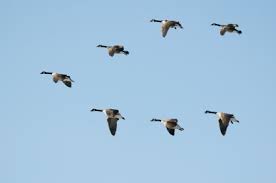Wild Goose Chase

One of my closest friends in years gone by had a real thing for Geese. He loved them as they reminded him so much of God. Celtic Christians had an interesting term for the Holy Spirit. They called it “Ah Geadh-Glas”, or the Wild Goose. They were on to something. Those of us who are Christians know that the Holy Spirit is someone that cannot be tracked or tamed.
But I have always thought this name for God to be strange. A goose is a loud, strident bird… not peaceful or pretty like a dove, but wild, raucous and unmissable. But the older I get, the more I realise how apt this name for the Holy Spirit can be.
The Celts were so aware that the life of faith is a daily journey, an adventurous pilgrimage. It is a flight into the unknown.
The power-house of the Celtic Church and mission was their commitment to a life of prayer and fasting. The written prayers we have from their era indicate a strong devotion to the Trinity and a constant invocation of God’s powerful presence.”¨”¨ Spiritual warfare was a constant reality for them, and often men and women would devote themselves to long times of prayer, even years, as in the case of Cuthbert’s nine years on the Isle of Farne.
ҬӬContemplative prayer was a common experience among Celtic believers; that is, prayer which listened, which waited for God rather than constantly bringing requests to Him.ӬӬ
Fasting was regularly practiced twice a week, on Wednesday and Friday, from rising until the afternoon prayer time (about three o’clock).
This month we have been encouraged to fast and pray specifically at church to seek God for our future.
Fasting requires sacrifice, thought, contemplation and choice. It exercises some of the gifts of the spirit – patience and in my case, self-control!
I discovered this Celtic verse in my prayer time today written by Ray Simpson who runs the Celtic community on Lindisfarne.
“Holy Spirit, Wild Goose
Great Spirit,
Wild Goose of the Almighty
Be my eye in the dark places;
Be my flight in the trapped places;
Be my host in the wild places;
Be my brood in the barren places;
Be my formation in the lost places.”
I love this! I love how it encourages us to allow God to fly for us, with us and to see beyond what we can see.
A goose gets a bird’s eye view of what is happening.
Research has shown that as a goose flaps its wings, it creates ‘uplift’ for the bird following. By flying in a V formation the whole flock adds 71% greater flying range than if the bird flew alone. What a beautiful image of being in community that is!
When people share a common direction and sense of community they can reach their goals more easily because they are travelling on the thrust of one another.
Whenever a goose falls out of formation, it suddenly feels the drag and resistance of trying to fly alone, and quickly gets back into formation to take advantage of the ‘lifting power’ of the bird immediately in front.
If we have as much sense as a goose, we will stay in formation with those who are headed where we want to go and be willing to accept their help as well as give ours to others.
When the lead goose gets tired, it rotates back into the formation and another goose flies at the point position.
It pays to take turns doing the hard tasks, and sharing leadership. With other people, as with geese, we are interdependent on each other.
We are on a Wild Goose chase, but not alone – together!
